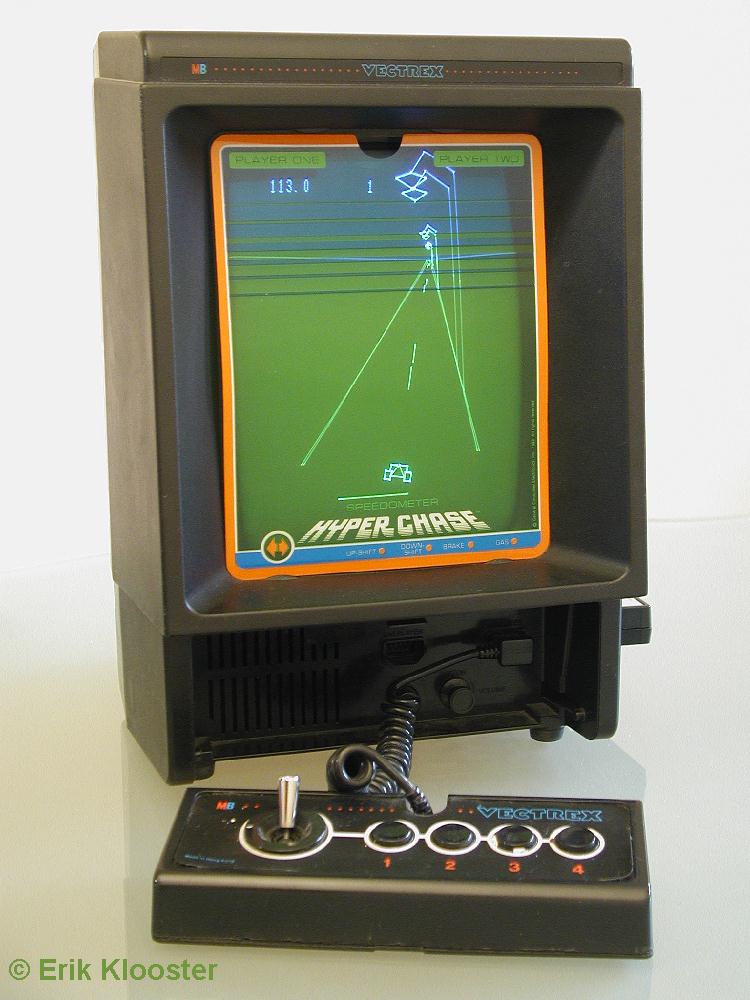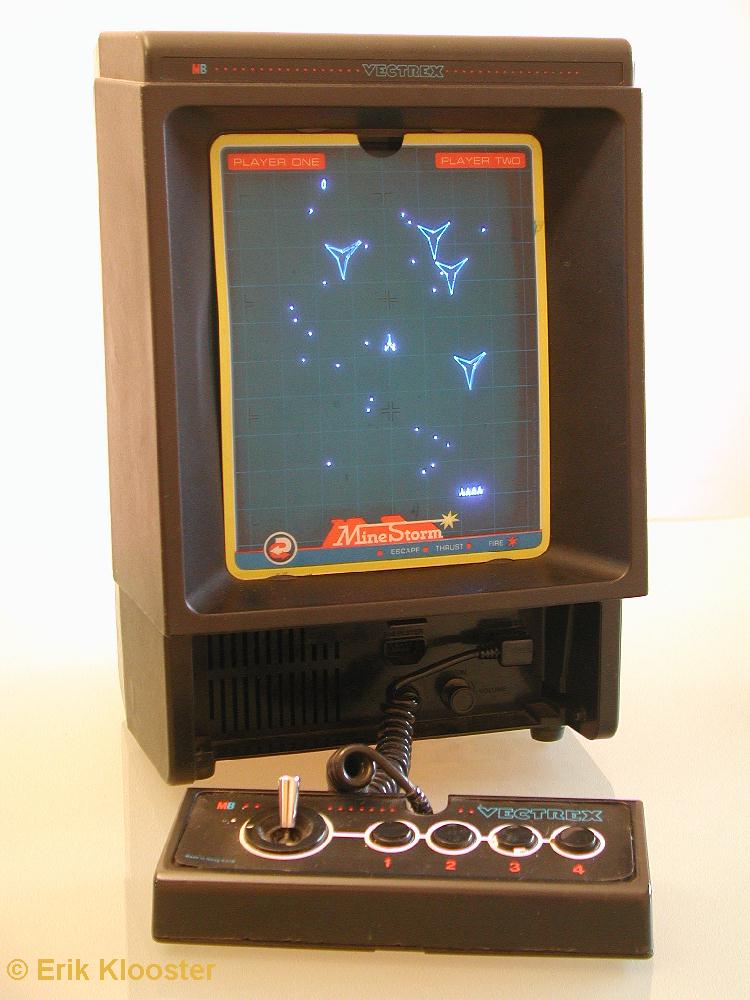
HISTORY OF HOME AND GAME COMPUTERS

| Navigator | ||||||||||||||||||
|
|
|
|
||||||||||||||||
|
|
||||||||||||||||||
|
The best bits As said the Vectrex had a second port,
for which one could buy an extra joystick. But actually this didn't make
much sense, because on most of the Vectrex games it wasn't possible to play
simultaneous. And then besides of those accessories
there were plenty of ideas. General Consumer Electronics e.g. wanted to
change the Vectrex into a real home computer set. Planned were a
keyboard, a modem, disk drive and printer. There also (still) exists a
prototype of a Vectrex with a colour display.
|
Welcome to the nostalgic
history of home and game computers

VECTREX - pearl among the game consoles
The Vectrex had many ingredients to become a big success in the early eighties, but for several reasons this striking game console failed to fulfil this promise. But this doesn't bother today's collectors: because of the design the Vectrex and all accessories have become items he MUST have.
Among the game consoles the appearance of the Vectrex was unique: an elongated monitor that was hidden about three inches deep in an arcade-like, black case. The player immediately thought himself in his own arcade. Also unique was the controller of the Vectrex. Hidden in the lower end of the case it was invisible, but once outside the controller turned out to have enormous proportions: it measured 8 x 3 inches, with four buttons and a self-centring joystick.
Pinpoint-sharp images  The Vectrex owed its name to the vector technique that was used in the
arcades (for instance in Asteroids and Space War), but until then not yet in
game consoles. Different from the raster technique in the usual screens, it
wasn't necessary to project all points of the screen again and again: the
projection could be limited to those parts of the screen that were in use at
that moment. The result were pinpoint-sharp images. The Vectrex owed its name to the vector technique that was used in the
arcades (for instance in Asteroids and Space War), but until then not yet in
game consoles. Different from the raster technique in the usual screens, it
wasn't necessary to project all points of the screen again and again: the
projection could be limited to those parts of the screen that were in use at
that moment. The result were pinpoint-sharp images.Also typical, although not directly favourable, were the overlays like the ones used with the Magnavox Odyssey ten years before. Because the Vectrex had a black-and-white monitor, it was decided to supply every game with its own coloured and transparent overlay, that could be attached to the screen. The overlays livened up the games and moreover protected the eyes for the bright and a bit blinking light that was typical of the vector technique. The Vectrex was sold with a build-in game, Mine Storm, a derivative of the arcade hit Asteroids. The other games were sold on cartridges, which could be plugged into the right side of the console that one would have placed on their adjustable desk. All together more then thirty different cartridges appeared in the stores. |
Father of the Vectrex
The 'Father of the Vectrex' was Jay Smith together with his companies Western
Technology and Smith Engineering. The idea for a 'mini- arcade' was born in the
early eighties, initially thought with a 5-inch monitor. Smith and co. in July
1981 went with it to Kenner, but this company didn't like it. But General
Consumer Electronics (GCE), known because of it's game & watches, was
enthusiastic and wanted to cooperate with Smith, on condition that a bigger
monitor would be used. And that's how, after code names like HP-3000 and
Vector-X, the Vectrex with a 9-inch screen was born. Manufacturing of the
newcomer among the game consoles started in the summer of 1982 and in November
1982 the first Vectrex consoles appeared in American stores. Now, for 199 dollar, the
consumer could create his own arcade.
 Clearance prices Clearance pricesAlthough General Consumer Electronics quickly sold it's stock of Vectrex consoles, the company had to contend with financial difficulties. In the beginning of 1983 GCE was bought by Milton-Bradley (MB), the game manufacturer that in the 'electronic part' of the market had big successes with Simon, but that was rather envious of the profits manufacturers like Mattel had with real consoles. MB immediately decided to expand the Vectrex to Europe. 1983 Became the most important year in the short history of this special game console. Then the Vectrex was sold in many places in the United States and Europe, and in that year the most game cartridges were manufactured. 32
Million loss |
Long live the Vectrex!
But... the Vectrex isn't really dead. All the rights on the Vectrex and
related stuff went back to Smith Engineering. Without profit motive the
company makes possible the distribution of cartridge-ROMS, overlays and
manuals.
In 1988 Smith Engineering even developed plans to come with a handheld
model of the Vectrex, but it abandoned the plan because of the imminent
coming of the Nintendo Game Boy.
|
Only for hardcore gamers An important pro GCE and MB stressed in their commercials was that the Vectrex had its own monitor, so that unlike when using other game consoles, the television didn't need to be annexed. This argument may have been useful in Europe, but in the U.S. many households meanwhile had more than one television. |
Specifications of the Vectrex
| Manufacturer |
General
Consumer Electronics in 1982/83 |
| Period | 1982 to 1984 |
| CPU | Motorola 68A09 |
| Frequency | 1,6 MHz |
| ROM | 8 KB (4 KB used by Mine Storm) |
| RAM | 2 x 1 KB |
| Colours | none |
| Sound | 3 channels through AY-3-8912 sound chip |
| I/O | cartridge, 2 joystick ports |
| Prices |
199
Dollar at the moment of introduction.
|
| News | |||
|
|
|
|
|
|
|
|||
View results from last poll: how many games you have? (3127 votes)
 It is difficult to find out the exact causes for the fact the Vectrex
didn't have the expected success. Clear is that the large-scale launch by
MB in 1983 was ill-starred, since a year later the video game industry
collapsed. But that's wisdom in retrospect.
It is difficult to find out the exact causes for the fact the Vectrex
didn't have the expected success. Clear is that the large-scale launch by
MB in 1983 was ill-starred, since a year later the video game industry
collapsed. But that's wisdom in retrospect.
